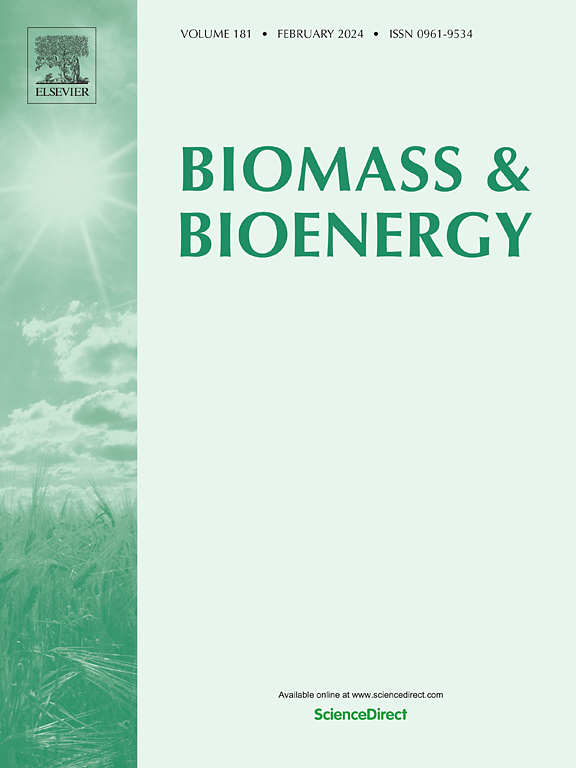Exploring the potential of novel feedstock (Caesalpinia bonduc seeds) for circular biodiesel production using seed shell-derived green nanocatalysts
IF 5.8
2区 生物学
Q1 AGRICULTURAL ENGINEERING
引用次数: 0
Abstract
Current work focuses on the investigation of newly explored Caesalpinia bonduc (L.) seed oil as an efficient and oil rich (45 % w/w) source for producing user friendly biodiesel during transesterification reaction. The whole process was facilitated using green nanocatalyst (K2O) synthesized from discarded Caesalpinia bonduc seed coat as reducing agent. About 98.27 % Caesalpinia biodiesel yield was attained with 1:6 oil to methanol, 0.15 (wt. %) K2O nanocatalyst at 120 °C temperature and 120 min interval. GCMS studies of Caesalpinia biodiesel depicts the presence of seven major peaks with retention time (12.640, 17.072, 18.722, 18.816, 18.981 and 23.921 min) confirms the successful conversion of Caesalpinia oil to corresponding biodiesel. The fuel properties of Caesalpinia biodiesel were 70 °C Flash point, 0.36 mgKOH/g Acid number, 0.89 kg/L Density, 3.52 Kinematic viscosity, 0.0063 % Sulphur, −12 °C Pour point, −8 °C Cloud Point are in excellent hormony with global bifuel standards. The green K2O nanocatalyst exhibits excellent reusability for up to 9th runs exhibiting its maximum reactivity up to three cycles. The outcomes of this investigation led to the conclusion that the non-conventional and non edible oil seeds of Caesalpinia bonduc (L.) Roxb and green K2O nanocatalyst is a viable, low-cost and sustainable and highly reactive contenders for future biodiesel industry with the potential to mitigate energy glitches along with positive and healther socio economic wellbeing of community at global level.

探索利用种子壳衍生的绿色纳米催化剂生产循环生物柴油的新原料(梭子鱼种子)的潜力
目前的工作重点是在酯交换反应中,研究新发现的凯撒皮属植物(Caesalpinia bonduc, L.)种子油作为高效和富油(45% w/w)的来源,用于生产用户友好型生物柴油。以废杉木种皮为原料合成绿色纳米催化剂(K2O)作为还原剂,促进了整个工艺的进行。在120°C温度下,以0.15 (wt. %) K2O纳米催化剂为催化剂,以1:6的油比甲醇为原料,间隔120 min,产率可达98.27%。对Caesalpinia生物柴油的GCMS研究显示,停留时间为12.640、17.072、18.722、18.816、18.981和23.921 min的七个主要峰的存在证实了Caesalpinia油成功转化为相应的生物柴油。该生物柴油的燃效为:闪点70°C,酸值0.36 mgKOH/g,密度0.89 kg/L,运动粘度3.52,硫含量0.0063%,倾点- 12°C,浊点- 8°C,符合国际双燃料标准。绿色K2O纳米催化剂具有优异的可重复使用性,可达9次运行,其最大反应活性可达3次循环。本研究的结果表明,该植物的非常规油籽和非食用油籽具有较好的营养价值。Roxb和绿色K2O纳米催化剂是一种可行的、低成本的、可持续的、高活性的未来生物柴油行业的竞争者,具有缓解能源故障的潜力,同时在全球范围内为社区带来积极和健康的社会经济福祉。
本文章由计算机程序翻译,如有差异,请以英文原文为准。
求助全文
约1分钟内获得全文
求助全文
来源期刊

Biomass & Bioenergy
工程技术-能源与燃料
CiteScore
11.50
自引率
3.30%
发文量
258
审稿时长
60 days
期刊介绍:
Biomass & Bioenergy is an international journal publishing original research papers and short communications, review articles and case studies on biological resources, chemical and biological processes, and biomass products for new renewable sources of energy and materials.
The scope of the journal extends to the environmental, management and economic aspects of biomass and bioenergy.
Key areas covered by the journal:
• Biomass: sources, energy crop production processes, genetic improvements, composition. Please note that research on these biomass subjects must be linked directly to bioenergy generation.
• Biological Residues: residues/rests from agricultural production, forestry and plantations (palm, sugar etc), processing industries, and municipal sources (MSW). Papers on the use of biomass residues through innovative processes/technological novelty and/or consideration of feedstock/system sustainability (or unsustainability) are welcomed. However waste treatment processes and pollution control or mitigation which are only tangentially related to bioenergy are not in the scope of the journal, as they are more suited to publications in the environmental arena. Papers that describe conventional waste streams (ie well described in existing literature) that do not empirically address ''new'' added value from the process are not suitable for submission to the journal.
• Bioenergy Processes: fermentations, thermochemical conversions, liquid and gaseous fuels, and petrochemical substitutes
• Bioenergy Utilization: direct combustion, gasification, electricity production, chemical processes, and by-product remediation
• Biomass and the Environment: carbon cycle, the net energy efficiency of bioenergy systems, assessment of sustainability, and biodiversity issues.
 求助内容:
求助内容: 应助结果提醒方式:
应助结果提醒方式:


